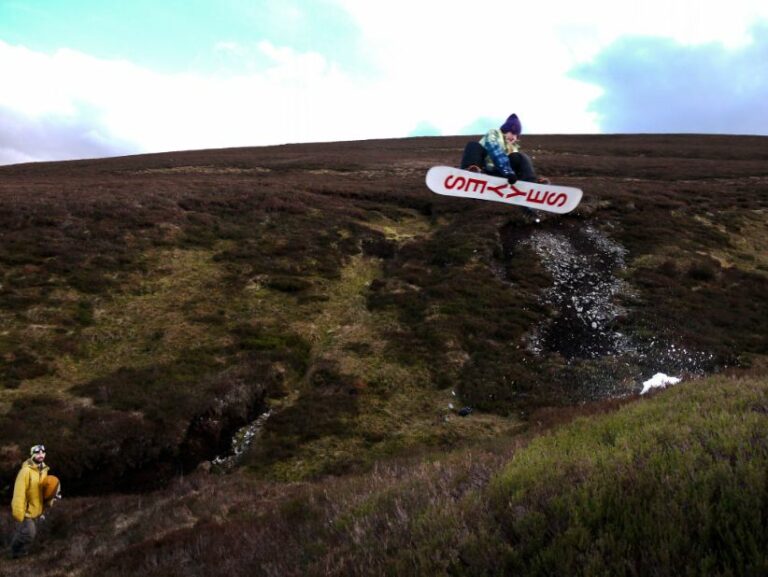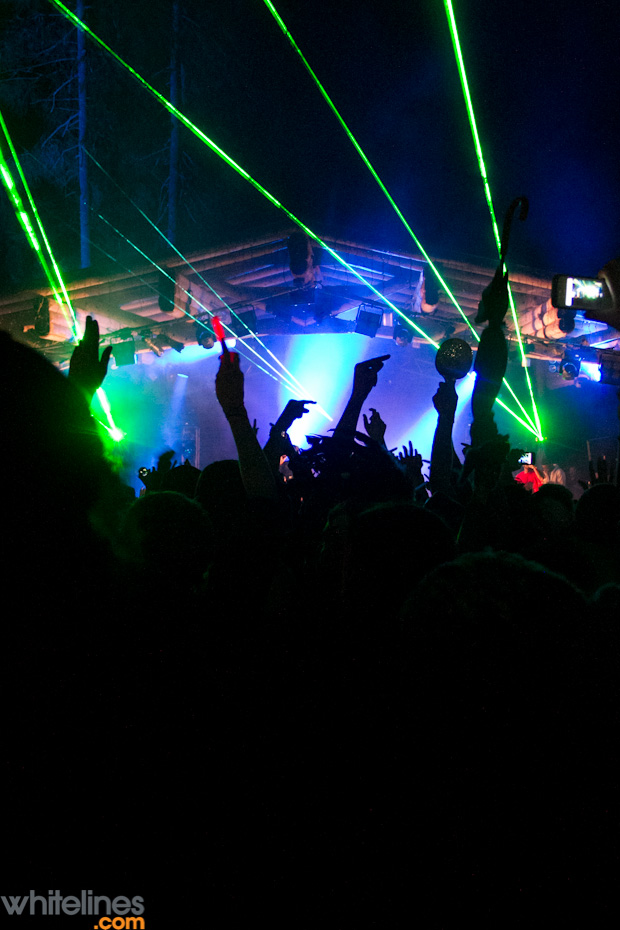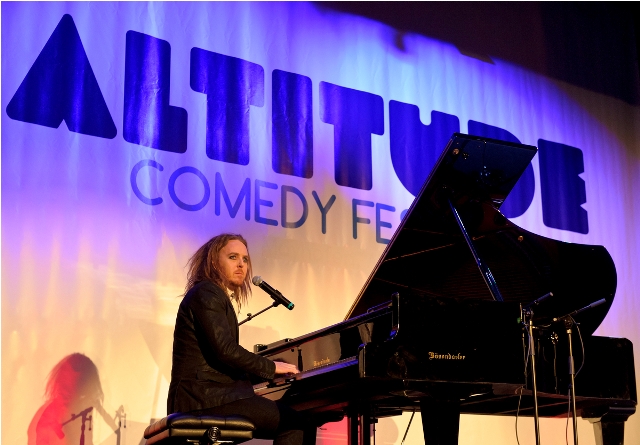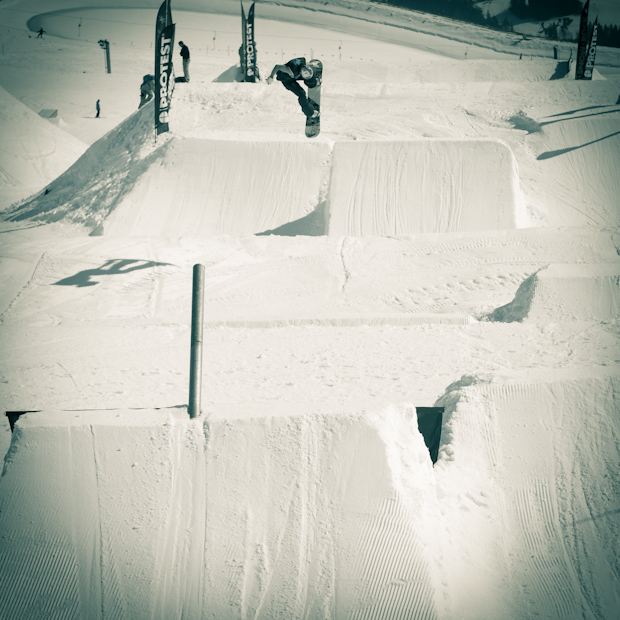Interview: Ed / Pictures: Hansi Herbig
Since masterminding the Robotfood movies, pushing the riding envelope and helping develop kicker design, David Benedek has been flying under the radar of late. In true style, though, he’s not been resting on his laurels. We tracked him down to find out more about his latest creative challenge.
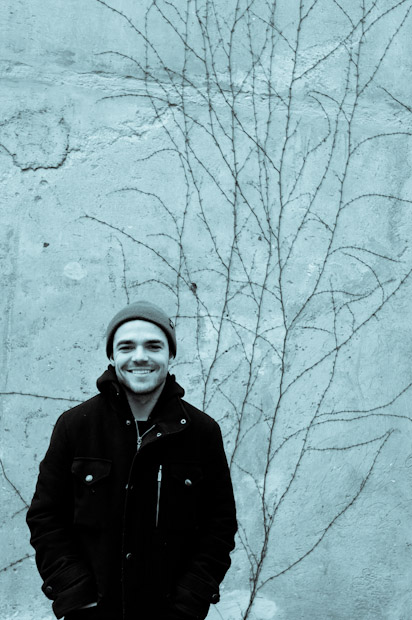
Why did you decide to write a book?
I’d had the idea for a long time. Just the physical aspect of creating a book I thought was really intriguing. But I never had a subject I thought was worth making a book about. Then – I don’t wanna say I grew out of snowboarding, but as I got older and the focus changed – I was like, ‘Wow. Is stuff changing or am I just getting older?’ And that became my idea. There was a central question I wanted to answer. Snowboarding’s fairly small compared to other industries but people don’t talk to each other that much outside their own companies, so I thought it’d be nice to talk to everyone and see what a collective opinion on the current state of snowboarding would be.
So who is interviewed?
Let’s see… Jake Burton, Richard Woolcott (Volcom CEO), Terje, Drew Stevenson (TTR Founder), Pat Bridges (Snowboarder Mag editor), Blue Montgomery (Capita founder), Mikey LeBlanc… then there’s a bunch of random kids who filled out surveys… Shaun Palmer, Scotty Wittlake, Whitey (Blunt Mag editor), Ken Block, Nicolas Müller, Mike Basich, Jed Anderson, Peter Line, JP Walker, Travis Rice, freeride Jeremy Jones, Wolle Nyvelt, Marc Frank Montoya, Danny Davis and Jess Burtner…
Wow. So a real who’s who of snowboarding over the years!
Yeah, a very subjective who’s who I guess. There’s a lot of people who might be more significant but I don’t think they necessarily offer such an interesting opinion. I wanted to look at different angles, you know?
Who was the most interesting to talk to?
To me, probably [former Lib Tech pro] Scotty Wittlake. Just because he’s got such a far-out standpoint on a lot of things. He comes from an almost anarchist background, where he just didn’t wanna be part of any marketing machine.
Did you do them all in person?
Yeah. I was really lucky, I basically took one round trip during the summer, to the West Coast of the US. It was only 6 weeks and I managed to do 25 interviews.
These are all ‘insiders’ opinions, right? How did you get the thoughts of regular riders on the current state of snowboarding?
Obviously I couldn’t ask 15,000 people, so I had to do it qualitively. I had 25 surveys in Japan, the US, Scandinavia and central Europe – just a few in each market. And then I picked the ones that seemed to best represent the other answers.
And have you found a concensus? Have you answered your original question?
Yeah, there generally is a concensus. My question was: how much of the snowboarding that I grew up with – that was (debatably) a tad less commercialised – is still around? As opposed to now you have kids growing up with coaches, and riders are on cereal boxes. How much of the cultural content has been affected by growth? And my personal conclusion, having conducted all these interviews, is that for sure some things have changed: snowboarding’s larger, there’s more money, and there’s a different, more polished version of it being presented on the outside; but there’s a limit to how much it can really grow, and how much mainstream compatibility it has. For instance, a couple of months ago the Burton team came on their film tour, and I went for dinner with them. Afterwards we went back to the tour bus to have a beer, and it was so cool to see that these competitive, high performance snowboarders of today – guys like Kazu, Mikkel, Mark McMorris – are still just punk ass kids. They’re just as punk as anyone was in the ‘90s. And snowboarding’s never gonna be big enough to supervise these kids. So yeah, it’s grown, but it’s retained a lot of that really likeable amateurism.

Where did you source all the shots?
Pretty much every one of the best snowboard photographers that we’ve had over the last 20 years or so was willing to contribute. Of course I had a photo budget, but it was fairly pathetic. So I was able to tap into the libraries of [old legends] like Bud Fawcett and Trevor Graves, but also [the latest hot shot] Cole Barash and everyone in between. I can’t thank them enough.
And you designed it too? Were you learning as you went along?
Yeah. I’ve been designing stuff for 10 years or so, but as far as editorial design goes, that was pretty new. I’ve done a lot of posters and packaging, but nothing as complex as this, so that took me a long time. I had a very specific idea of where I wanted to go, which is where the lack of experience comes in, and was at times very frustrating.
What format does it take?
It’s actually two books that are fused at the spine. You open it out and there’s one on top of the other. Snowboarding’s such a visual thing, and it seems like you always have too many images to fit in with the text in a normal layout, so this was my solution. The bottom book is basically all interviews, and the top one is all photography. It’s cool when you have four pages that correlate with each other as opposed to just a spread; there’s a lot of cool stuff you can do with the design. And I played around with different paper stocks, so for instance the interviews are all on green, uncoated paper.
When and where is published?
Unfortunately it’s not the most financially viable project of all time, so there’s just a limited edition that’s available through a website called almostanything.com.
So it might be hard to get your hands on a copy?
It might be. I limited it to two copies per order, ‘cos I didn’t want people to hog, and I just want to make sure that people that really wanna get it can do so. But it’s an expensive piece of paper to produce, so I couldn’t publish too many.
How much is it?
It’s gonna be 89 euros. So it’s pretty spendy, but hopefully a nice thing to have. Besides all the initial questions and stuff, I just kinda wanted to create something that I can look at myself and be psyched on snowboarding. There’s so much cool stuff happening, I wanted to compile it. And not with too much nostalgia, ‘cos snowboarding’s very present.
So what’s next for you? What are you doing now?
I’m going to film school in Munich now. That’s quite a change! It’s a four year course – and that’s if you’re fast. I just wanted to look into some form of creative education ‘cos I’ve never done it.
Do you think you’d like to make ‘proper’ drama films?
I guess I could see myself doing it, but right now I’m just focused on learning how to direct better. You learn how to work as a team, and so many other aspects. I don’t think there’s another creative field that combines so many disciplines – like art direction, writing, music… Film is the one that has the biggest toolset, and it’s really nice to learn how to orchestrate that. Maybe the ‘work world’ is very different though, so we’ll see.

Are you still riding?
Yeah. But riding as in riding, not going out and shooting movies.
Do you think you’ll ever make another snowboard film?
Maybe if I wait long enough. It’d be really neat if I was stoked on doing one again and I had a better education in film and a better background in financing something outside the typical snowboard company formula. But as of right now, I’d rather venture off and keep snowboarding for myself.
What did you think of the Brain Farm films?
I think it’s great. Seriously, it’s incredible that someone is able to do a project on that scale in snowboarding, and with that reach. People always say “I wish the mainstream knew that snowboarding wasn’t just the Olympic halfpipe” and this is exactly what they’re getting now. They’re getting arguably – no, //the// – best rider in the world, on some of the best terrain. Would I change anything? I guess I wish there was a little more emotional engagement – arguably it’s more of an IMAX movie – but to be honest the images are so stunning that that alone already works. And seriously, when was the last time someone who didn’t win the Olympics got invited on the Conan O’Brien show [as Travis Rice did]? Of course this is all Red Bull PR money, but still it’s a very decent advert for snowboarding.
What do you think of the double cork beast you created?
[laughs] I think it’s a natural evolution. Things always have to be pushed further. But just to correct you, it wasn’t me who did the first double cork. JP Walker did one, and then Travis Rice did the first modern 1080 double cork – the one on the Pyramid Gap. JP’s looked more… I don’t wanna say accidental, but something that couldn’t be recreated every single time. People were like, “Wow this is really cool” but it didn’t really trigger much because it didn’t look like a fluid thing you could easily do on a park jump. But when we saw Travis’s, I was like “Holy shit! That really works, every single time.” And so, the only thing I did, was I may have been the first person to do it on a park jump, and then I did it in a contest. Maybe I was the first person to have it sorta on lock, so that’s why they associate me with the trick. But I don’t wanna slip my way out of your question [laughs]… I wish we hadn’t really gone to the triple right away – that’s kinda ridiculous – but if you look at double corks there’s some pretty insanely good looking ones. People push the technical side – including me, I mean god, a 1260 double cork? That wasn’t the most beautiful trick you could do. It was more for my own curiosity – but then a couple of years go by and they really put style into it. Style and technical progression always go in waves.

Did you see the triple rodeo video?
Yeah! That’s craaazy! It’s awesome that snowboarding’s being pushed, but the same thing I was just talking about applies. It’s nothing I wanna look at, but it’s pretty impressive. You can’t artificially stop progression, you just have to do your best to make sure it’s in line with what we as snowboarders would like snowboarding to be. But I’m sure that if the jump was three times the size and he did that smooth then it’d be a nice trick. And watching the stuff he did before? I was like “Holy shit! That’s the level people are riding at, just on a park day?” Double double double double. That’s nuts.
So where do we go now?
I think right now, what they should do with slopestyle is really put more creativity into the course building, to stop slopestyle becoming freestyle skiing. Because that’s a problem. A double cork’s fine, but watching three double corks in a row by every competitor is fucking boring. When I started, it was way more about different lines and different choices. They should build stuff that’s so odd you can’t even do a double cork – even if it’s ten whoop-di-doos into a drop down. Some crazy shit. It should be about who can ride this thing creatively.
That’s interesting, because your whole thing before was about building the perfect park jump, which has helped people to do double corks!
I don’t think one cancels out the other. They both have a purpose. If you just want a big jump, it shouldn’t be weird. Like if the X Games asked me what they should do for the Big Air, I’d say just build the perfect jump. But in slopestyle, do something crazy. Build a quarterpipe into a pyramid hip, and then two different choices… stuff that’s less linear, and that maybe allows less technicality to everyone – so that only the very best riders can show that technicality. In essence, I guess, they should make slopestyle more difficult.
But you know the competitors would bitch, right?
Yeah well. Fuck them. [laughs]
Do you think the step-over design you pioneered has caught on?
A little bit. I see a lot of jumps where at least the deck goes uphill. There was a time when you’d get a 10-metre high cheese wedge and then a straight deck, which is just dangerous. We certainly didn’t invent the step-over, but hopefully we put the focus back on not endangering people more than is necessary.
Thanks David. And good look with the film course!
Thanks.


